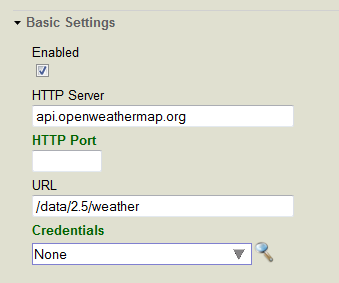REST オペレーションの開発
REST オペレーションを開発するには、EnsLib.REST.OperationOpens in a new tab クラスを拡張します。REST オペレーションは Ensemble の出力 HTTP アダプタを使用します。詳細は、"HTTP 送信アダプタの使用法" を参照してください。
HTTP 送信アダプタを使用する場合、HTTP アダプタ構成の外部 Web サービスのサーバ、ポート、およびアドレスを指定します。例えば、天気のサービスを呼び出す REST オペレーションを定義するには、以下のようにオペレーションを構成します。

EnsLib.REST.OperationOpens in a new tab の拡張で、アダプタの URL プロパティに値を付加して、URL の残りの部分を指定します。次に、使用する HTTP オペレーションに応じて、以下のいずれかのアダプタ・メソッドを呼び出します。
-
GetURL()— HTTP GET オペレーションを使用します。
-
PostURL()— HTTP POST オペレーションを使用します。
-
PutURL()— HTTP PUT オペレーションを使用します。
-
DeleteURL()— HTTP DELETE オペレーションを使用します。
-
SendFormDataArray()— HTTP オペレーションをパラメータとして指定できます。
たとえば、以下の EnsLib.REST.OperationOpens in a new tab の拡張は、天気の REST サービスを呼び出して、都市名をパラメータとして提供します。
Class Test.REST.WeatherOperation Extends EnsLib.REST.Operation
{
Parameter INVOCATION = "Queue";
Method getWeather(
pRequest As Test.REST.WeatherRequest,
Output pResponse As Test.REST.WeatherResponse) As %Status
{
try {
// Prepare and log the call
// Append the city to the URL configured for adapter
Set tURL=..Adapter.URL_"?q="_pRequest.City_"&units=imperial"
// Execute the call
Set tSC=..Adapter.GetURL(tURL,.tHttpResponse)
// Return the response
If $$$ISERR(tSC)&&$IsObject(tHttpResponse)&&$IsObject(tHttpResponse.Data)&&tHttpResponse.Data.Size {
Set tSC=$$$ERROR($$$EnsErrGeneral,$$$StatusDisplayString(tSC)_":"_tHttpResponse.Data.Read())
}
Quit:$$$ISERR(tSC)
If $IsObject(tHttpResponse) {
// Instantiate the response object
set pResponse = ##class(Test.REST.WeatherResponse).%New()
// Convert JSON into a Proxy Cache Object
set tSC = ..JSONStreamToObject(tHttpResponse.Data, .tProxy)
if (tSC){
// Set response properties from the Proxy Object
set pResponse.Temperature = tProxy.main.temp_"F"
set pResponse.Humidity = tProxy.main.humidity_"%"
set pResponse.MaxTemp = tProxy.main."temp_max"_"F"
set pResponse.MinTemp = tProxy.main."temp_min"_"F"
set pResponse.Pressure = tProxy.main.pressure_" mbar"
set pResponse.WindSpeed = tProxy.wind.speed_" MPH"
set pResponse.WindDirection = tProxy.wind.deg_" degrees"
// Convert from POSIX time
set pResponse.Sunrise = $ZT($PIECE($ZDTH(tProxy.sys.sunrise, -2),",",2),3)
set pResponse.Sunset = $ZT($PIECE($ZDTH(tProxy.sys.sunset, -2),",",2),3)
}
}
}catch{
Set tSC=$$$SystemError
}
Quit tSC
}
XData MessageMap
{
<MapItems>
<MapItem MessageType="Test.REST.WeatherRequest">
<Method>getWeather</Method>
</MapItem>
</MapItems>
}
}
オペレーションに送信されたメッセージは、都市を指定します。
Class Test.REST.WeatherRequest Extends (%Persistent, Ens.Util.MessageBodyMethods)
{
Property City As %String;
}
このオペレーションは、JSONStreamToObject() メソッドを呼び出し、JSON の要素をアクセス可能にする Caché オブジェクトを返します。このサンプルによって返されたメッセージは、JSON ストリームから取得された以下のプロパティを返します。
Class Test.REST.WeatherResponse Extends (%Persistent, Ens.Util.MessageBodyMethods)
{
Property Temperature As %String;
Property MinTemp As %String;
Property MaxTemp As %String;
Property Pressure As %String;
Property Humidity As %String;
Property WindSpeed As %String;
Property WindDirection As %String;
Property Sunrise As %String;
Property Sunset As %String;
}
実行中のビジネス・プロセスがない場合は、Ensemble, プロダクション構成 で、このオペレーションおよび他のオペレーションを実行およびテストできます。これを行うには、オペレーションを選択して、[プロダクション設定] メニューの [アクション] に移動し、[テスト] をクリックします。